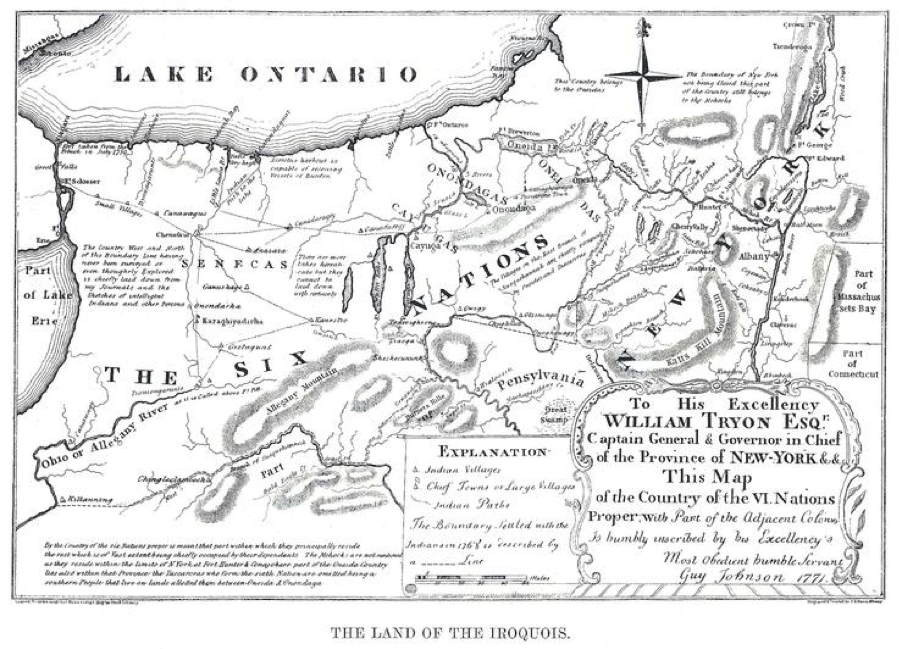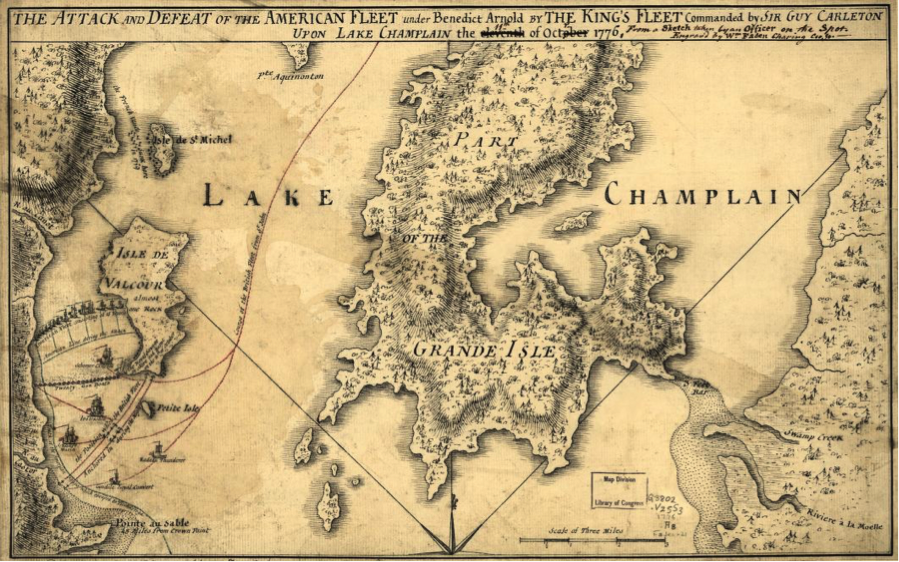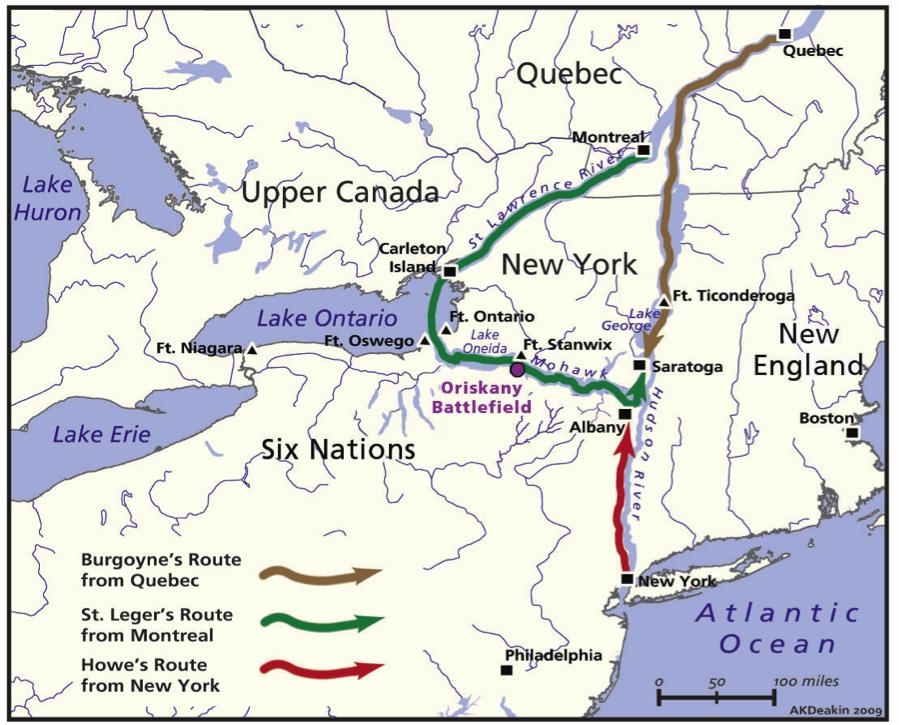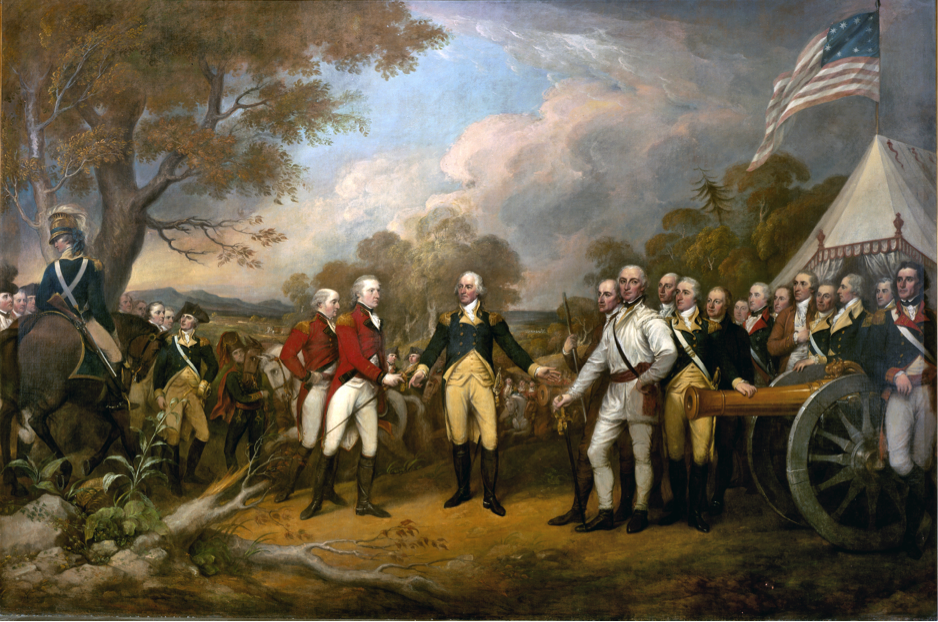
[ Back to Historical Fiction ] -> [ Back to Hamilton and Peggy: A Revolutionary Friendship ]
Philip Schuyler's War
Hamilton and Peggy: A Revolutionary Friendship
Peggy’s father, Philip Schuyler, was vitally important to the Patriot fight, one of those lesser-known “founding fathers” without whom we may have lost our Revolution. Perhaps because our War for Independence stretched on for eight bloody years, its battles scattered across the East Coast, we often only study its opening shots, what happened in Boston and New York City, and its determining battle at Yorktown, Virginia. But much of the war was fought in smaller skirmishes, neighbor against neighbor, and in wildernesses. This is particularly true in upstate New York, whose saga culminated in the Battles of Saratoga, a precious victory, one of our first, which convinced the French to join our cause.
Philip Schuyler commanded the Northern Army during most of this time. But that fact is not well known, largely because he gave up his military career in late 1777. For more about his other crucially important efforts as one of George Washington’s most trusted spymasters, as Iroquois negotiator, and as a dogged scrounger of supplies and men for the Patriot forces see his entry in “Major Players.”
Below is a timeline of the battles during which General Schuyler commanded Patriot forces and the terrifying enemy threats, civilian panic, and constant crises Peggy Schuyler had to face and survive as his daughter.
1775:
(dates in italics are battles happening simultaneously to Schuyler’s command but elsewhere)
April 15: Lexington and Concord
May 10: Benedict Arnold and Ethan Allen seize Ticonderoga from the British, capturing desperately needed cannons.
http://www.history.com/topics/american-revolution/capture-of-fort-ticonderoga
June 17 : Battle of Bunker Hill
https://www.britannica.com/event/Battle-of-Bunker-Hill
https://www.smithsonianmag.com/history/the-true-story-of-the-battle-of-bunker-hill-36721984/
June 25: Philip Schuyler given command of the Northern Army
July: General Schuyler establishes headquarters at Ticonderoga with 2,900 untrained and poorly supplied troops.
Aug 23: Also charged by Congress to be the chief negotiator and “Indian agent,” Schuyler holds a conference with the Six Nations of the Iroquois trying to secure their support against the British. Ultimately, two tribes will ally with the Patriots (the Oneida and Tuscarora) and the remaining four with the British. (For more, see “The Oneida Sachem” under my “Supporting Characters”)
https://www.britannica.com/topic/Iroquois-Confederacy
http://www.americanrevolution.org/ind1.php

Aug 29: British man-of-war bombards NYC
August/Sept: Schuyler marches the Northern Army into Canada. The Patriots are convinced French Canadians will rise up against the British and join their rebellion. Schuyler is debilitated with gout and returns to Ticonderoga, yielding field command for the expedition to General Richard Montgomery.
Nov. 13: General Montgomery captures Montreal, after laying siege to Fort St. Jean.
http://www.history.com/this-day-in-history/patriots-take-montreal
Dec. 31: Battle of Quebec
Facing the expiration of troop enlistment at the end of the year, Montgomery leads a nighttime charge on the city’s fortifications in the middle of a blizzard. However, British forces are prepared and open fire, killing Montgomery and badly wounding Arnold. More than 400 Patriots are taken prisoner, injured, or killed. Americans retreat. Many delegates in Congress blame Schuyler for the defeat, even though he wasn’t there.
http://www.history.com/topics/american-revolution/battle-of-quebec-1775
1776:
Jan 9: Thomas Paine publishes Common Sense
https://www.gutenberg.org/files/147/147-h/147-h.htm
March 4-17: American forces capture Dorchester Heights, overlooking Boston harbor. Using cannons captured from Fort Ticonderoga, the patriots bombard the British, who evacuate and set sail for New York. George Washington rushes to New York City to set up defenses.
April: Schuyler escorts a Congressional Delegation, including Benjamin Franklin, to Saratoga to inspect his troops, convincing them that the Northern Army is in desperate need of more men, money, and arms.
June: General John Sullivan evacuates Canada, relocating to Fort Ticonderoga.
June 21: The Hickey Plot to assassinate GW by one of his own bodyguards is thwarted.
June-July: A massive British war fleet arrives in New York Harbor, with 30 battleships, 1200 cannons, 30,000 soldiers, 10,000 sailors, and 300 supply ships. General William Howe and his brother Admiral Lord Richard Howe command.
July 4th: The Declaration of Independence
Aug 22-29: Howe lands 15,000 British troops in Long Island with 40 cannons to attack Washington’s Continentals. Suffering terrible losses and outnumbered 2 to 1, Washington withdraws to Brooklyn Heights. The British expect his surrender in the morning. But, in the first of many astounding escapes, Washington evacuates his soldiers across the East River in small boats and a sudden dense fog that cloaks their movements. He will retreat up Manhattan Island to Harlem Heights. From then on, Washington will avoid large-scale European-style battles. His ability to “hit and run,” vaporizing into the countryside will earn him the nickname “old fox” with many British commanders.
Sept. 15: British occupy NYC; landing at Kipp's Bay
16: Battle of Harlem Heights
21: Trinity Church and 492 buildings in NYC destroyed by fire
Oct: British troops under command of Sir Guy Carleton invade upstate New York using Lake Champlain.

Oct 11: The Battle of Valcour Island. The British fleet of 87 gunboats attack an inexperienced American Navy near Valcour Island on Lake Champlain. Despite the fact most of the American flotilla is destroyed, the battle is a tactical and moral success for the Patriots. Under command of Benedict Arnold, the Patriots manage to hold off the British longer than expected, and then, in the darkness of night, using muffled oars for their boats, evacuate troops along the lake to safety. They delay the British advance long enough that Carleton stops, knowing winter is coming. Had he kept marching, Carleton probably could have gone straight through to take Albany, gaining control of the Hudson River. Instead, he maintains control of Lake Champlain but withdraws to Canada for the winter, allowing Washington and the Continentals to regroup and plan for the spring campaign. Arnold’s reputation as a valiant and stubborn fighter becomes legendary.
https://allthingsliberty.com/2014/01/battle-valcour-island/
Oct. 23: Washington withdraws from Manhattan
28: The Battle of White Plains
http://www.mountvernon.org/digital-encyclopedia/article/battle-of-white-plains/
Nov. 16: British forces capture Fort Washington in Upper Manhattan, just above Harlem Heights, seizing 100 Patriot cannons and thousands of muskets and cartridges—a terrible loss of armaments for the Patriots.
20: Cornwallis captures Fort Lee in NJ directly across the Hudson from NYC
23: Of the 20,000 soldiers he had that summer, GW is down to 5,410 men.
Dec. 11: Desperate to save what army he has from capture, Washington takes his troops across the Delaware River into Pennsylvania. The next day, fearing the British might capture the city, Congress abandons Philadelphia and relocates to Baltimore.
Dec. 19: Thomas Paine writes “These are the times that try man's souls...”
Dec 22: Schuyler’s Northern Army digs in at Ticonderoga to fortify it as the stronghold that would stop British invasion from Canada. They barricade its northern approach on Lake Champlain with a floating breastwork of logs and chains. Writes Schuyler, "The poor creatures (what's left alive) laying on the cold ground, in poor thin tents, and some not at all, and many down with the pleurisy. No barracks, no hospitals...your heart would melt...not one pair of shoes nor blanket in the store." He begs Congress for 4500 men to fill the militia quota.
https://www.fortticonderoga.org/
https://allthingsliberty.com/2015/10/winter-soldiering-in-the-lake-champlain-valley/
Dec. 25-26: Washington crosses the ice-filled Delaware River to attack the Hessians at Trenton
http://www.mountvernon.org/digital-encyclopedia/article/battle-of-trenton/
https://history.army.mil/news/2014/141200a_trenton.html
http://www.history.com/topics/american-revolution/battles-of-trenton-and-princeton
1777:
April 21-28: The British attack the small, idyllic town of Danbury, Connecticut, torching its houses, farms, and shops plus Continental supply depots containing 1,500 tents, 500 pairs of shoes, 4,000 barrels of beef, 5,000 of flour, all meant to sustain Patriot soldiers. Finally, Benedict Arnold, General David Wooster, and General Gold Silliman lead a counter-attack on the British. Although they stop the carnage at Danbury, they fail to prevent the British from continuing their campaign in Connecticut on their way to Long Island Sound.
May 6: General Johnny Burgoyne arrives in Quebec to begin plans for the British invasion of New York. He envisions a three-prong attack: from the north down Lake Champlain to Lake George to the Hudson River; from the west along Lake Ontario to the Mohawk River; from the south up the Hudson River from New York City. All three forces were to converge on and crush Albany in order to gain control of the Hudson River. The goal: to control the entire Hudson River, thereby severing the states, cutting off New England from the others.
Philip Schuyler’s inexperienced Northern Army is the force that must stop Burgoyne’s 7,500 English and Hessian professional soldiers and 400 Iroquois warriors.

June 16: The Patriots evacuate Crown Point, a strategic stronghold where Lake Champlain and Lake George connect. Patriots retreat to Mount Independence and Fort Ticonderoga to take a stand against Burgoyne.
https://parks.ny.gov/historic-sites/34/details.aspx
July 5: Fort Ticonderoga falls. The British break through in a mere 30 minutes the flotilla defense of chains and logs it took the Americans 10 months to build. The Redcoats then manage to scale and haul cannons to the top of Mount Defiance, overlooking Fort Ticonderoga. General St. Clair must evacuate his 3,000 men to save the Patriots from inevitable capture or death rained down into the fort from the cliffs above them. But, for a long terrifying week, the whereabouts of the American soldiers is a mystery—prompting many to fear St. Clair has gone over to the British or that his entire army was captured.
July 7: The British seize Skenesboro.
http://www.lcmm.org/shipwrecks_history/history/history_revolution.htm
July 8: The Battle of Fort Anne. Americans are driven out, losing 128 cannons.
In the face of such devastating defeats, Philip Schuyler orders what is left of his forces to slow Burgoyne’s march through New York’s wilderness by felling trees into a thick tangle across paths, destroying bridges, and flooding marshes. He urges Patriot farmers and settlers to burn their crops and drive off livestock so the British army cannot feed itself with them. Burgoyne’s march slows to a crawl as his soldiers have to cut away dense thickets of obstacles, allowing Schuyler to hurriedly beg for reinforcements, arms and ammunition, and for the militia from New York, New Hampshire, Massachusetts, and Connecticut to rally.
July 9: George Clinton is elected New York’s first state governor, defeating Schuyler.
July 23: Angelica elopes with John Carter, an English adventurer working with Congress
July 27: A young woman named Jenny McCrea is murdered. One of the many miscalculations Burgoyne makes is to exploit Americans’ fear of native Indians in the belief it will cow them into submission. He issues threatening proclamations and rewards tribes allied with the British for attacking settlements and Patriot scouting parties. He reportedly pays them for scalps. As Burgoyne’s army approaches Fort Edward, just north of Saratoga, and civilians flee before his advance, Jenny McCrea is killed. The exact truth of what happened, how and why she dies, is unknown, but her murder becomes the rallying cry for local militia, who purposefully fuel panic to steel Patriot resolve. The Northern Army’s numbers swell, making it a viable force for the upcoming Battles of Saratoga.
http://www.newenglandhistoricalsociety.com/jane-macrae-murdered-on-the-way-to-her-loyalist-lover/
July 27: In Philadelphia, a 19-year-old Lafayette arrives to volunteer his services. At first, Congress turns him away.
July 30: Burgoyne takes Fort Edward.
August 4- 22: The Siege of Fort Stanwix and the Battle of Oriskany.
British Lt. Colonel Barry St. Leger crosses Lake Ontario to land at Oswego, charged with taking Fort Stanwix and control of the Mohawk River as his route to Albany. St. Leger commands 300 regulars, 650 Canadian and Tory militia, plus 1,000 American Indians led by John Butler and Mohawk chief Joseph Brant. A young patriot colonel named Peter Gansevoort and his meager force inside the fort refuse to surrender, even under St. Leger’s threat to allow his allied Indians to do whatever they want when the British inevitably take the fort. Gansevoort and his men answer by tearing up old shirts to create a makeshift American flag and raise it in defiance.
Meanwhile, Philip Schuyler had been alerted to Burgoyne’s three-prong attack plan by one of his spies and double-agent couriers. He sends word to Nicolas Herkimer to take his 800 Tyron County militia to help the fort. On their march, the ill trained farmer-soldiers are ambushed by Tories with Mohawk and Seneca warriors. Oneida tribesmen rush to the Patriots’ aid but the losses are terrible at Oriskany—one family losing seven of nine sons. Old Herkimer is shot through the thigh in the first volley, but drags himself to a tree and smokes a pipe to dull his pain as he continues to direct the fighting.
Schuyler then dispatches Benedict Arnold to take on St. Leger’s force. Arnold hopes to recruit militia as he marches, but gathers only 100 volunteers, leaving his numbers at only 900. He resorts to a clever subterfuge—sending in a captive claiming to have escaped from the dreaded Arnold and an enormous American Army. St. Leger disengages and returns to Canada.
August 16: Battle of Bennington. The Patriots’ first major victory against Burgoyne's forces. The British suffer 207 casualties, as well as losing roughly 700 prisoners to the Continental Army. This victory gave the Patriots major momentum going into the Battles of Saratoga.
http://www.mountvernon.org/digital-encyclopedia/article/battle-of-bennington/
Aug 19: Despite his slowing Burgoyne’s advance and stopping the British from taking the Mohawk River, Congress is swayed by Schuyler’s detractors who blame him for the fall of Ticonderoga. Schuyler learns that he has been relieved of his command of the Northern Army and replaced by General Horatio Gates, who had lobbied hard against him.
Sept. 11: The Battle of Brandywine. Washington’s troops are defeated. Marquis de Fleury and Lafayette are both wounded. Congress flees Philadelphia and the British occupy the city on Sept. 26.
Sept. 19- Oct. 17: The Battles of Saratoga (see description below)
Oct. 6: To support Burgoyne, General Clinton sails up the Hudson from NYC, capturing Fort Clinton and Montgomery (just below West Point) and burning the towns of Esopus and Kingston.
Oct 10: During fighting around Saratoga, Burgoyne torches Philip Schuyler’s country estate, crops, and mills, after briefly using the house as his headquarters.
The "First" Battle of Saratoga, often referred to as the Battle of Freeman's Farm, begins September 19th. With Burgoyne's men quickly gaining on them, Benedict Arnold and Colonel Daniel Morgan convince Horatio Gates to send them (along with a force of sharpshooting riflemen) on a guerilla attack. While they have initial success, eventually British and Hessian reinforcements overtake them. Arnold and Morgan are forced to retreat. Embarrassed and furious, Gates dismisses Arnold from his field command.
Unbeknownst to Gates, however, Burgoyne's army is rapidly dwindling, anxiously awaiting reinforcements from General Henry Clinton. American forces, on the other hand, rallied by calls from Schuyler and alarmist propaganda regarding the death of Jenny McCrea, are growing rapidly, swelling to just under 10,000 men.
Help is not to come. After his initial forays (see Oct. 6th), Clinton is ordered back to New York City by Howe. Burgoyne is left to fend for himself.
On October 7th, after refusing his officers’ plan for retreat, Burgoyne sends 1,500 troops, under Brigadier Simon Fraser, to attack the Patriot encampment. While marching, Fraser stops (less than a mile away from the American base camp) to reorganize his men. A number of Continental riflemen, hiding in surrounding woodlands, use this opportunity to attack in what will become the Battle at Bemis Heights. Benedict Arnold—despite being ordered to stand down by Gates—leaps on his horse and leads a fresh assault that surprises and routs the British. (Arnold is yet again shot in the leg during his charge, leaving him with a permanent limp and pain. This wound, the war’s destruction of his wealth, Congress’ dislike and refusal to promote him, and his treatment by Gates during Saratoga spawn a bitterness that leads to Arnold later turning traitor. )
Burgoyne's men, now completely on the defensive, retreat, but Brigadier General John Stark and Gates completely surround them.
October 17: Burgoyne formally surrenders, guaranteed that his men will be allowed to go back to England with the promise never to return to North America during the War. Burgoyne has lost 86% of his troops—an astronomical number, especially given the overwhelming early British successes. In addition to bolstering American resolve and moral, as well as depleting British forces, the Battles of Saratoga convince the French that the Patriots can actually fight and win battles. The French join the Patriots’ cause—their alliance invaluable in America's ultimate victory.
https://www.nps.gov/sara/index.htm
https://www.britannica.com/event/Battles-of-Saratoga
http://www.ushistory.org/us/11g.asp
https://www.nps.gov/sara/learn/historyculture/index.htm
John Trumball’s depiction of the surrender ceremony:

See the link below to know who is in the painting and where. Philip Schuyler, who prepared the army for this victory, attends the surrender, but stands in civilian garb behind the cannon. He wears a brown coat, his hand to his breast.
https://www.aoc.gov/sites/default/files/painting_key_surrender-of-general-burgoyne_aoc.png
A few days later, Burgoyne and his entourage of officers arrive at the Schuyler Mansion as guests to await their deportation. Schuyler remains in Saratoga to rebuild his destroyed house and mills as quickly as possible before the onset of winter, leaving Catharine and Peggy to deal with entertaining their enemy.
